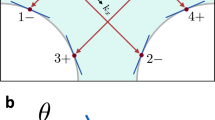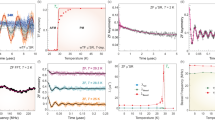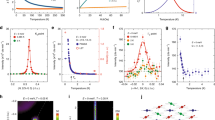Abstract
The origin of magnetic order in metals has two extremes: an instability in a liquid of local magnetic moments interacting through conduction electrons, and a spin-density wave instability in a Fermi liquid of itinerant electrons. This dichotomy between ‘local-moment’ magnetism and ‘itinerant-electron’ magnetism is reminiscent of the valence bond/molecular orbital dichotomy present in studies of chemical bonding. The class of heavy-electron intermetallic compounds of cerium, ytterbium and various 5f elements bridges the extremes, with itinerant-electron magnetic characteristics at low temperatures that grow out of a high-temperature local-moment state1. Describing this transition quantitatively has proved difficult, and one of the main unsolved problems is finding what determines the temperature scale for the evolution of this behaviour. Here we present a simple, semi-quantitative solution to this problem that provides a basic framework for interpreting the physics of heavy-electron materials and offers the prospect of a quantitative determination of the physical origin of their magnetic ordering and superconductivity. It also reveals the difference between the temperature scales that distinguish the conduction electrons’ response to a single magnetic impurity and their response to a lattice of local moments, and provides an updated version of the well-known Doniach diagram2.
This is a preview of subscription content, access via your institution
Access options
Subscribe to this journal
Receive 51 print issues and online access
$199.00 per year
only $3.90 per issue
Buy this article
- Purchase on Springer Link
- Instant access to full article PDF
Prices may be subject to local taxes which are calculated during checkout


Similar content being viewed by others
References
von Löhneysen, H., Rosch, A., Vojta, M. & Wölfle, P. Fermi-liquid instabilities at magnetic quantum phase transitions. Rev. Mod. Phys. 79, 1015–1075 (2007)
Doniach, S. The Kondo lattice and weak antiferromagnetism. Physica B 91, 231–234 (1977)
Hewson, A. C. The Kondo Problem to Heavy Fermions (Cambridge Univ. Press, 1993)
Nakatsuji, S., Pines, D. & Fisk, Z. Two fluid description of the Kondo lattice. Phys. Rev. Lett. 92, 016401 (2004)
Curro, N. J., Young, B.-L., Schmalian, J. & Pines, D. Scaling in the emergent behavior of heavy-electron materials. Phys. Rev. B 70, 235117 (2004)
Yang, Y.-F. & Pines, D. Universal behavior in heavy-electron materials. Phys. Rev. Lett. 100, 096404 (2008)
Nakatsuji, S. et al. Intersite coupling effects in a Kondo lattice. Phys. Rev. Lett. 89, 106402 (2002)
Hegger, H. et al. Pressure-induced superconductivity in quasi-2D CeRhIn5. Phys. Rev. Lett. 84, 4986–4989 (2000)
Marabelli, F. & Wachter, P. Temperature dependence of the optical conductivity of the heavy-fermion system CeCu6 . Phys. Rev. B 42, 3307–3311 (1990)
Satoh, K., Fujita, T., Maeno, Y., Ōnuki, Y. & Komatsubara, T. Low-temperature specific heat of CexLa1-xCu6 . J. Phys. Soc. Jpn 58, 1012–1020 (1989)
Aliev, F. G., Brandt, N. B., Moshchalkov, V. V. & Chudinov, S. M. Electric and magnetic properties of the Kondo-lattice compound CeCu2Si2 . J. Low Temp. Phys. 57, 61–93 (1984)
Goremychkin, E. A., Osborn, R. & Muzychka, A. Yu. Crystal-field effects in PrCu2Si2: An evaluation of evidence for heavy-fermion behavior. Phys. Rev. B 50, 13863–13866 (1994)
Dürkop, D. et al. Antiferromagnetic order and 4f-instability of CePb3 . Z. Phys. B 63, 55–61 (1986)
Lin, C. L., Wallash, A., Crow, J. E., Mihalisin, T. & Schlottmann, P. Heavy-fermion behavior and the single-ion Kondo model. Phys. Rev. Lett. 58, 1232–1235 (1987)
Besnus, M. J., Braghta, A. & Meyer, A. Kondo behaviour in magnetic (Ce-La)Pd2Si2 . Z. Phys. B 83, 207–211 (1991)
Palstra, T. T. M. et al. Superconductivity in the ternary rare-earth (Y, La, and Lu) compounds RPd2Si2 and RRh2Si2 . Phys. Rev. B 34, 4566–4570 (1986)
Ghosh, K., Ramakrishnan, S., Malik, S. K. & Chandra, G. Resistivity and magnetic-susceptibility studies in the RPd2Al3 (R = La, Ce, Pr, Nd, and Sm) system. Phys. Rev. B 48, 6249–6254 (1993)
Medina, A. N., Rojas, D. P., Gandra, F. G., Azanha, W. R. & Cardoso, L. P. Change of the Kondo regime in CePd2Al3 induced by chemical substitution: Verification of the Doniach diagram. Phys. Rev. B 59, 8738–8744 (1999)
Zapf, V. S., Dickey, R. P., Freeman, E. J., Sirvent, C. & Maple, M. B. Magnetic and non-Fermi-liquid properties of U1-xLaxPd2Al3 . Phys. Rev. B 65, 024437 (2001)
Kitaoka, Y., Arimoto, H., Kohori, Y. & Asayama, K. NMR study of the dense Kondo compound CeRu2Si2 . J. Phys. Soc. Jpn 54, 3236–3239 (1985)
Matsuhira, K. et al. Single-site and inter-site effects in heavy fermion compound CeRu2Si2 studied by constant volume dilution. J. Phys. Soc. Jpn 66, 2851–2863 (1997)
Ott, H. R., Rudigier, H., Delsing, P. & Fisk, Z. Magnetic ground state of a heavy-electron system: U2Zn17 . Phys. Rev. Lett. 52, 1551–1554 (1984)
Takagi, S., Suzuki, H. & Anzai, K. Kondo effect of U impurities in dilute (YU)2Zn17 . J. Phys. Soc. Jpn 70, 3098–3106 (2001)
Yokoyama, M., Amitsuka, H., Kuwahara, K., Tenya, K. & Sakakibara, T. Anomalous Fermi liquid behavior of the dilute uranium alloys La1-xUxRu2Si2 (x≤0.07). J. Phys. Soc. Jpn 71, 3037–3042 (2002)
van der Meulen, H. P. et al. Field suppression of the heavy-fermion state in CeRu2Si2 . Phys. Rev. B 44, 814–818 (1991)
Sonier, J. E. et al. μ+ Knight shift measurements in U0. 965Th0. 035Be13 single crystals. Phys. Rev. Lett. 85, 2821–2824 (2000)
Kim, J. S., Andraka, B., Jee, C. S., Roy, S. B. & Stewart, G. R. Single-ion effects in the formation of the heavy-fermion ground state in UBe13 . Phys. Rev. B 41, 11073–11081 (1990)
Kyogaku, M. et al. NMR and NQR studies of magnetism and superconductivity in the antiferromagnetic heavy fermion superconductors UM2Al3 (M = Ni and Pd). J. Phys. Soc. Jpn 62, 4016–4030 (1993)
Li, S. et al. Physical properties of Lu1-xYbxNi2B2C. Phil. Mag. 86, 3021–3041 (2006)
Jullien, R., Fields, J. N. & Doniach, S. Zero-temperature real-space renormalization-group method for a Kondo-lattice model Hamiltonian. Phys. Rev. B 16, 4889–4900 (1977)
Acknowledgements
We thank our colleagues at the August 2007 ICAM workshop on 1-1-5 materials, where this work originated, for many useful discussions and V. Sidorov for sharing unpublished measurements of the resistivities of LaRhIn5 and La0.975Ce0.025RhIn5 at pressures to 5 GPa. Y.Y. wishes to thank ICAM for the fellowship that has made this collaboration possible. Z.F. was supported by NSF grant NSF-DMR-0710492. D.P. acknowledges support from start-up funding from the Physics Department of the University of California, Davis. Work at Los Alamos was performed under the auspices of the US Department of Energy, Office of Science, and supported in part by the Los Alamos Directed Research and Development program.
Author Contributions The data analysis is primarily due to Y.Y., with some contributions from D.P., who with Z.F. developed some of the basic physical ideas tested here. Experiments on Ce1-x Lax</emph>RhIn5 under pressure were carried out by H.-O.L. and J.D.T.
Author information
Authors and Affiliations
Corresponding author
Supplementary information
Supplementary information
The file contains Supplementary Discussion with Supplementary Table 1, Supplementary Figures and Legends 1-7, and additional references, describing in detail the different methods used to estimate T* and TK for each material. All data souces are included in Supplementary Table 1. (PDF 652 kb)
PowerPoint slides
Rights and permissions
About this article
Cite this article
Yang, Yf., Fisk, Z., Lee, HO. et al. Scaling the Kondo lattice. Nature 454, 611–613 (2008). https://doi.org/10.1038/nature07157
Received:
Accepted:
Issue Date:
DOI: https://doi.org/10.1038/nature07157
This article is cited by
-
Observation of Kondo condensation in a degenerately doped silicon metal
Nature Physics (2023)
-
Construction of conducting bimetallic organic metal chalcogenides via selective metal metathesis and oxidation transformation
Nature Communications (2022)
-
Dual Kondo effect charge ordering and zero thermal expansion in a correlated intermetallic
Communications Materials (2022)
-
Bandwidth-control orbital-selective delocalization of 4f electrons in epitaxial Ce films
Nature Communications (2021)
-
Kondo scenario of the γ–α phase transition in single crystalline cerium thin films
npj Quantum Materials (2020)
Comments
By submitting a comment you agree to abide by our Terms and Community Guidelines. If you find something abusive or that does not comply with our terms or guidelines please flag it as inappropriate.



